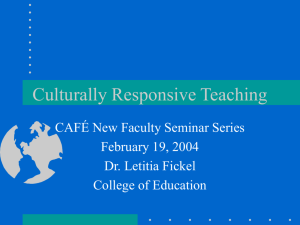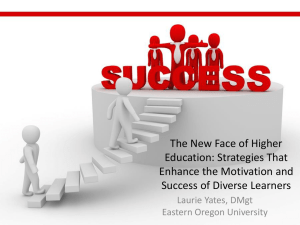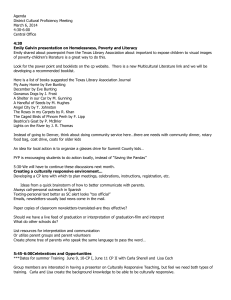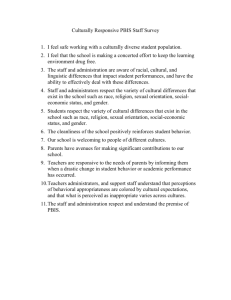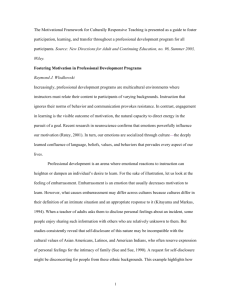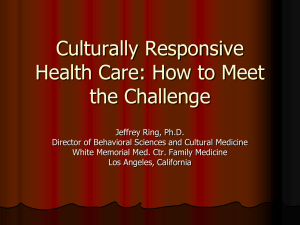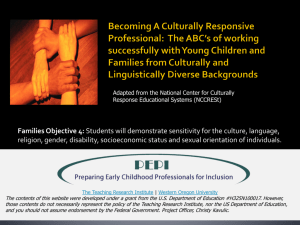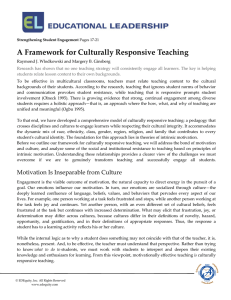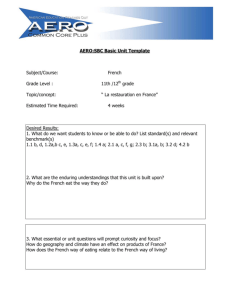Course Review Classes 1-5 & Creating Motivating Learning
advertisement
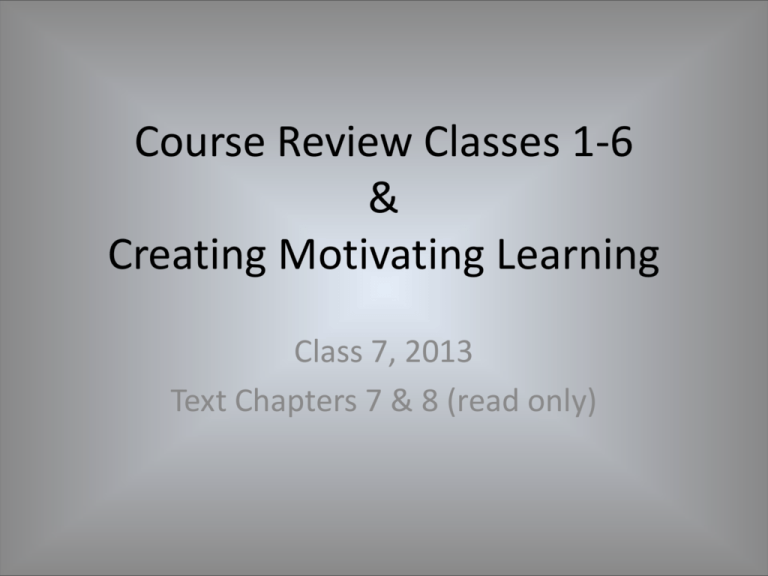
Course Review Classes 1-6 & Creating Motivating Learning Class 7, 2013 Text Chapters 7 & 8 (read only) Objectives: Part I • TSWBAT successfully pass Quiz#2 • TSWBAT: examine the dynamics of motivation in the adult teaching context. • TSWBAT: apply Wlodkowski & Ginsberg’s “Motivational Framework for Culturally Responsive Teaching” to an adult educational scenario. Review of Previous Classes • Handout: Class Objectives Motivation and Learning • Learning Community Questions: – What issues and / or experiences shape an adult learner’s motivation to learn? – If the class was culturally diverse what additional issues would the teacher need to consider? Introduction to Motivation • What drives you? • Conclusion: • Motivation is shaped by our culture, society, beliefs, values, personality, environment, physical condition, life experiences, gender. Discussion: Case Study • Context – Adult teaching – Subject matter (class decides) – Cultural background of S (class decides) – Geographic location (class decides) • Challenge – I want to be a better teacher. – What motivates the S? How might the following shape the S’s motivation? • • • • • • • Society Beliefs and values Personality Environment Physical condition of S Life experiences Gender Why study motivation? • “all students can learn” versus • “all students can learn in a motivating way.” WHY? • If educators are better informed about motivation they can better encourage student learning • “Knowledge about motivation can give all students a better chance to learn” (Ginsberg, 2005, “Cultural Diversity, Motivation, and Differentiation.” In Theory into Practice, Summer Vol 44, 3, p. 218. • “Determination to find ways to encourage motivation is fundamental to equity in teaching and learning, and is a core virtue of educators who successfully differentiate instruction” (Tomlinson & Allan as cited by Ginsberg, 2005, p. 219) Part I: Understanding Motivation Definitions: • “a tendency within a person to produce organized and directed behavior” (MacKeracher, D., 2004, Making sense of adult learning, p. 131). • “the intensity of one’s impetus to learn” (Brown, D. 2007, Teaching by principles). • “the natural human capacity to direct energy in the pursuit of a goal” (Wlodkowski, In Galbraith, Adult learning methods, p. 142). Two Basic Types of Motivation • Extrinsic • Intrinsic • Intrinsic motivation is the more powerful of the two and longer lasting. Ausubel’s Drive theory • Exploration: probe unknown • Manipulation: we control our environment • Activity: be physically active • Stimulation: receptive to stimulation • Knowledge: yearns for answers • Ego enhancement: build self-esteem Wlodkowski’s Primary Sources of Motivation • Be curious • Be active • Initiate thought and behavior • Make meaning from experience • Effective at what we value Cultures differ on what elicits frustration, joy, determination. To be an effective teacher of adults we must be culturally responsive in our teaching. Cultural Differences “From Foreign to Familiar” Relationship vs Task orientation Direct vs Indirect communication Individualism vs Group identity Inclusion vs Privacy Different concepts of hospitality High-context vs Low-context cultures Different concepts of time and planning Brown “orientation” & “motivation” • Orientation: context or purpose for learning – Integrative Orientation • To integrate into culture or society – Instrumental Orientation • Career goal or practical reason • Motivation: “the intensity of one’s impetus to learn.” Application of Brown’s Differentiation • Understanding adult’s orientations towards learning will help us with understanding the student, and directing us toward classroom activities that are deemed as important to the students (meaningful). • Understanding the importance and role of intrinsic and extrinsic motivation will help us as teachers to design specific classroom activities / lesson plans and to manage the classroom in a way that empowers learning. Part II: Challenge of Motivation in Adult Education Classes: Diversity of students • What fuels adult’s motivation to learn: – Desire to make sense of their world – Desire to find meaning – Desire to be effective at what they value • Key to effective instruction: – “to evoke and encourage” … “the propensity in all adults…to be competent in matters they hold to be important” (p. 141). • Problem of Teaching Adults: – Diversity of adults (cultural differences with differing needs, and perspectives) presents a great challenge to teaching adults. Part III: The Model: A motivational framework for culturally responsive teaching “4 essential motivational conditions that in concert evoke intrinsic motivation among culturally diverse adult learners” (p. 144) 1. Establishing inclusion (Relationships): learners and teachers feel respected and connected 2. Developing attitude (Relevance): personal relevance and choice 3. Enhancing meaning (Rigor): include learner’s perspectives and values (engagement and challenge) 4. Engendering competence (Results): learners are effective in learning something they value (effectiveness and authenticity) Value of Framework 1. Model for motivation in action 2. Organizational aid for designing instruction Wlodkowski, R. (2004). Creating motivating learning environments. In M. Galbraith (3rd ed.), Adult teaching methods. p. 145. Strategies Strategies for Establishing Inclusion – Multidimensional sharing – Collaborative learning – Participation guidelines Strategies for Developing Attitude – Relevant learning models (witnessing people similar to themselves who perform learning goals) – The K-W-L strategy • What they think they know about topic • What they want to know about the topic • What they have learned about the topic Strategies con’t Strategies for Enhancing Meaning – Posing a problem (problem: “any situation where a person wants to achieve a goal for which an obstacle exists” (citing Voss, 1989) on page 158 of Galbraith – Creating a simulation – Providing variety Strategies for Engendering Competence – – – – Consistent and prompt feedback Authentic performance tasks for assessment (see page 160 for characteristics of “authentic” Early clarification of assessment tasks and criteria Application • You are teaching a culturally diverse group of parents / adults who what to learn how to download, send, receive, save, and view family pictures they receive via email. • What strategies could be employed for each of the above? • Handout: 4 conditions…and teacher questions Review Objectives • TSWBAT: examine the dynamics of motivation in the adult teaching context. • TSWBAT: apply Wlodkowski & Ginsberg’s “Motivational Framework for Culturally Responsive Teaching” to an adult educational scenario. Next Class • No Class Next Week: Spring Break • Monday, March 25th: – Chapter 9: Guidelines for selecting methods – Chapter 10 Case Story • OUT of CLASS LESSON PLAN & PAPER – DUE: Monday March 25thth (Monday after Spring Break)
